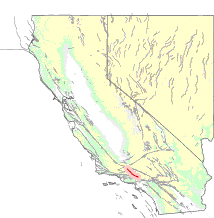San Gabriel Fault

The San Gabriel Fault is a geological fault in Los Angeles County, California, running about 87 miles (140 km) southeastward from the Ridge Basin in the Sierra Pelona-San Emigdio Mountains juncture area to the western San Gabriel Mountains that forms their southwestern face near Sunland and the northeastern San Fernando Valley, and then on the south flank to the southeastern part of the San Gabriel range.
Location and age
[edit]The San Gabriel Fault is a right-lateral strike-slip that was last active between 10 and 5 million years ago[1] — Late Quaternary west of intersection with the Sierra Madre Fault, and Quaternary east of that intersection, and Holocene only further west between Saugus and Castaic-Gorman.
The San Gabriel Fault started 13-11 million years ago as a large part of the San Andreas Fault,[2] and is believed to be the former path of it. It is part of the San Gabriel Fault Zone, which starts in the northwestern corner of the Ridge Basin, splits into two faults in its southeastern section, in the northwestern San Gabriel Mountains, and ends in the eastern part of those Mountains.[3] The San Gabriel Fault is the north branch. It is older and goes eastward from the south branch which is younger, the Vazquez Creek Fault.
It is also believed that the northwestern end of this fault zone meets the current San Andreas Fault zone beneath the Frazier Mountain Thrust, near the juncture of the San Andreas with the Garlock Fault and Big Pine Fault.[4]
Orientation and movement
[edit]Different areas of the fault have different types of separation: normal or reverse. It is normal in the northwest portion of the fault (Castaic Hills Oil Field), and reverse/thrust in the southeast (southeast of Honor Rancho Oil Field).[5] The San Gabriel Fault moves at a rate of between 1 and 5 millimeters a year, with an average slip of around 3 millimeters. Overall, it has 22-23 km of right separation east of the Vazquez Creek Fault, and a total amount of 42 km.[6][7]
Some strata dip away from the fault (in the northwestern portion) and other strata dip toward the fault (in the east, but only in the southeast portion), with the Saugus Oil Field having the greatest amount of split in the dip. The overall dip is 65°–85° NE.[8] If these two segments were rotated horizontal, the dip becomes almost 90 degrees, and so it is thought that the dip started out to be almost vertical and rotated to its present northeast dip from folding and horizontal shortening.[5]
The fault is therefore made up of two sections. In the northwest the strike is northwest and normal separation. In the southeast there is a west-northwest strike and reverse separation. In the northern part there are mountains, the southern part has little land formations. The northern part is considered inactive, while the southeast part near Honor Rancho Oil Field is thought to be active due to evidence of Holocene sediment displacement.[5]
References
[edit]- ^ Powell, Robert E. (1993), "Chapter 1: Balanced palinspastic reconstruction of pre-late Cenozoic paleogeology, southern California: Geologic and kinematic constraints on evolution of the San Andreas fault system", The San Andreas Fault System: Displacement, Palinspastic Reconstruction, and Geologic Evolution, Geological Society of America Memoirs, vol. 178, Geological Society of America, pp. 1–106, doi:10.1130/mem178-p1, ISBN 0-8137-1178-9, retrieved 2023-10-24
- ^ Gath, Eldon (2010-01-01). "The San Gabriel Fault: A Summary of its Structural History and Neotectonics". South Coast Geological Society Field Trip Guidebook.
- ^ Beyer, Larry A.; McCulloh, Thane H.; Denison, Rodger E.; Morin, Ronald W.; Enrico, Roy J.; Barron, John A.; Fleck, Robert J. (2009). "Post-Miocene Right Separation on the San Gabriel and Vasquez Creek Faults, with Supporting Chronostratigraphy, Western San Gabriel Mountains, California". Professional Paper. doi:10.3133/pp1759. ISSN 2330-7102.
- ^ "San Gabriel fault zone/faultmaps". usgs.gov. Archived from the original on 2006-09-23.
- ^ a b c Yeats, Robert S.; Stitt, Leonard T. (2003), "Ridge Basin and San Gabriel Fault in the Castaic Lowland, Southern California", Evolution of Ridge Basin, Southern California: an interplay of sedimentation and tectonics, Geological Society of America, doi:10.1130/0-8137-2367-1.131, ISBN 978-0-8137-2367-9, retrieved 2023-10-17
- ^ Powell, Robert E. (1993), "Chapter 1: Balanced palinspastic reconstruction of pre-late Cenozoic paleogeology, southern California: Geologic and kinematic constraints on evolution of the San Andreas fault system", The San Andreas Fault System: Displacement, Palinspastic Reconstruction, and Geologic Evolution, Geological Society of America Memoirs, vol. 178, Geological Society of America, pp. 1–106, doi:10.1130/mem178-p1, ISBN 0-8137-1178-9, retrieved 2023-10-24
- ^ Gath, Eldon (2010-01-01). "The San Gabriel Fault: A Summary of its Structural History and Neotectonics". South Coast Geological Society Field Trip Guidebook.
- ^ Bryant, W. A (2017). "San Gabriel Fault Zone, Honor Rancho Section, in Quaternary Fault and Fold Database of the United States" (PDF). www.usgs.gov. Retrieved 2023-10-24.
External links
[edit]- San Gabriel Fault – USGS
- San Gabriel Fault Zone – Southern California Earthquake Data Center
- Geoscienceworld.org: San Gabriel Fault
